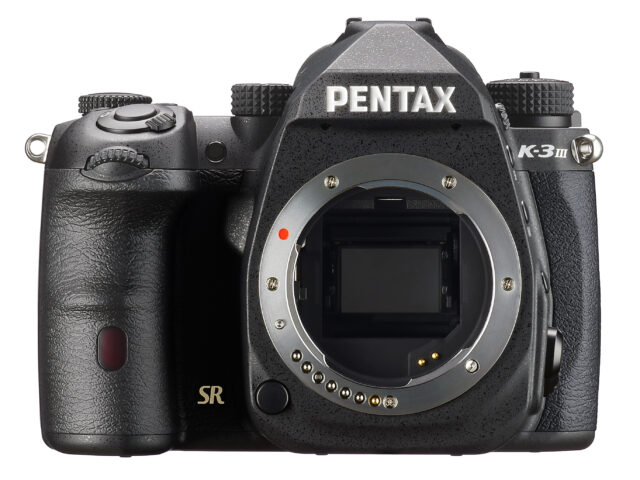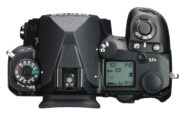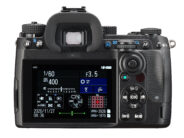Announced
Production status
System
Pentax K APS-C system cameras
- Pentax *ist D
- Pentax *ist DL
- Pentax *ist DL2
- Pentax *ist DS
- Pentax *ist DS2
- Pentax K-3
- Pentax K-3 II
- Pentax K-3 III
- Pentax K-3 III Monochrome
- Pentax K-30
- Pentax K-5
- Pentax K-5 II
- Pentax K-5 IIs
- Pentax K-50
- Pentax K-500
- Pentax K-7
- Pentax K-70
- Pentax K-m
- Pentax K-r
- Pentax K-S1
- Pentax K-S2
- Pentax K-x
- Pentax K100D
- Pentax K100D Super
- Pentax K10D
- Pentax K110D
- Pentax K200D
- Pentax K20D
- Pentax KF
- Pentax KP
Pentax K-3 III
APS-C AF digital SLR camera
Specification
| Format: | |
| APS-C | |
Imaging sensor: | 23.3 × 15.5mm CMOS sensor |
Resolution: | 6192 × 4128 - 26 MP |
Crop factor: | 1.55x |
Sensor-shift image stabilization: | Yes |
| Pentax K [45.5mm] | |
| Shutter: | |
Type: | Focal-plane |
Model: | Electronically controlled |
Speeds: | 30 - 1/8000 + B |
| Exposure: | |
Exposure metering: | Through-the-lens (TTL), open-aperture |
Exposure modes: | Programmed Auto |
| Aperture-priority Auto | |
| Shutter-priority Auto | |
| Manual | |
| Physical characteristics: | |
Weight: | 735g |
Dimensions: | 134.5x103.5x73.5mm |
Manufacturer description
PARSIPPANY, NJ, March 30, 2021 -Ricoh Imaging Americas Corporation today announced the PENTAX K-3 Mark III, the new flagship model in its APS-C format digital SLR camera series. Designed around the PENTAX Principles, the new camera offers advanced functions and outstanding imaging performance with a goal of optimizing the fun and excitement of photography in a wide variety of conditions.
The PENTAX K-3 Mark III builds on the PENTAX legacy of outstanding image quality, incorporating a back-illuminated CMOS image sensor with approximately 25.73 effective megapixels. By coupling this sensor with an AA (anti-aliasing)-filter-free optical design, the camera produces super-high-resolution images. A newly developed, high-performance PRIME V imaging engine and new-generation accelerator unit delivers well-defined images with minimal noise, while retaining high-resolution reproduction at all sensitivities. The PENTAX K-3 Mark III boasts a super-high sensitivity of ISO 1600000 and features a newly developed SAFOX 13 autofocus system with 101 focus sensors.
A new, super-bright optical viewfinder delivers a nearly 100% field of view and magnification of approximately 1.05 times. With a newly developed high-refraction glass prism, the viewfinder provides a wide field of view equivalent to that of a full-frame SLR, fully immersing the photographer in shooting.
The camera’s compact, rugged body is dustproof and weather resistant, making it suitable for use in the most extreme environmental conditions. It features PENTAX’s high-performance, five-axis shake-reduction (SR) system, minimizing camera shake to deliver sharp, blur-free images. Furthering its commitment to producing the highest quality images, the PENTAX K-3 Mark III features the innovative Pixel Shift Resolution System, employing advanced super-resolution technology to capture four images of the same scene by shifting the image sensor by a single pixel for each image, then synthesize them into a single composite image.
The PENTAX K-3 Mark III is equipped with user-friendly shooting functions, improved efficiency and operability. These include a high-definition 3.2-inch touch-screen LCD monitor—the first touch screen in the PENTAX K series. The screen allows intuitive operation of a variety of functions, including scrolling menu selection and image zooming during playback.
The camera also features PENTAX Real-time Scene Analysis System, supported by the latest artificial intelligence technology. It can instantly detect a subject’s face and eyes using advanced image recognition technology and makes a real-time analysis of the subject’s movement. The system assists the camera in optimizing exposure settings and improving autofocusing accuracy, assuring more accurate subject detection and more reliable scene judgment.
“The development of the PENTAX K-3 Mark III has been a longtime labor of love,” said Kaz Eguchi, president, Ricoh Imaging Americas Corporation. “At Ricoh, our goal is to develop high-quality cameras with the power to capture images that speak louder than words and inspire photographers to continue pursuing their passion for photography every day.”
Ricoh is also producing two limited-edition kits -- the PENTAX K-3 Mark III Black Premium Kit and PENTAX K-3 Mark III Silver Premium Kit. These special packages include a camera body and battery grip (the Silver Premium Kit comes with a silver camera body and a silver battery grip that is exclusive to this package), plus an exclusive leather strap and a spare battery. The specifications of the limited-edition models are identical to those of the PENTAX K-3 Mark III. The Premium Kits will be available in late April for the manufacturer’s suggested retail price of $2,299.95.
| The Five Principles of PENTAX |
- We design new cameras through sheer devotion.
- Our goal is to produce cameras with the power to capture images that allow for direct communication with the subject.
- We design cameras that allow our users to enjoy all the processes involved in taking a picture.
- We pursue a level of quality and performance that can’t be measured by numbers alone.
- We respect and value the photographic experiences of our users and view this as an invaluable asset.
| Main features of the PENTAX K-3 Mark III |
1.Optical viewfinder with nearly 100% field of view and approximately 1.05-times magnification
The PENTAX K-3 Mark III features an optical viewfinder with a nearly 100-percent field of view and a magnification of approximately 1.05 times. A newly developed, high-refraction glass prism assures comfortable viewing with a wide field of view equivalent to that of a full-frame SLR. Also, by using a distortion-correcting optical element and optimizing the lens coatings, it delivers a clear, true-to-life viewfinder image free of distortion, with brightness improved by nearly 10 percent over the PENTAX K-3 II’s viewfinder. Incorporating a Natural Bright Matte III focusing screen — known for ease of focus during manual-focus shooting — it also delivers a sharp, clear subject image with faithful reproduction of the bokeh (defocus) effect. In addition, its transparent display lets the user monitor a wide range of operational data in the viewfinder window.
2.High-resolution images assured by approximately 25.73 effective megapixels and super-high-sensitivity photography at a top sensitivity of ISO 1600000
As part of its passion for higher image quality, PENTAX equipped the PENTAX K-3 Mark III with a back-illuminated CMOS image sensor with approximately 25.73 effective megapixels. By coupling this sensor with an AA (anti-aliasing)-filter-free optical design, the camera produces super-high-resolution images. PENTAX also renewed all key devices, including the newly developed, high-performance PRIME V imaging engine and new-generation accelerator unit to deliver well-defined images with minimal noise, while retaining high-resolution reproduction at all sensitivities — even in the super-low or super-high range. Also, by greatly improving the noise-reduction performance at high-sensitivity ranges, it boasts a top sensitivity of ISO 1600000 to extend the range of scenes that can be photographed.
3.Pentax SR II Shake Reduction System delivers high-performance, 5-Axis, 5.5-shutter-step camera shake compensation
(1) In-body SR mechanism, compatible with all mountable lenses*
The built-in SR II shake-reduction mechanism means that the PENTAX K-3 Mark III effectively minimizes camera shake and delivers sharp, blur-free images, even in camera-shake-prone conditions such as when using a telephoto lens, shooting low-light scenes without flash illumination, or photographing sunset scenes. In addition to horizontal and vertical camera shake caused by pitch and yaw, this five-axis mechanism compensates for camera shake caused by horizontal and vertical shift (often generated in macro photography) and camera shake caused by roll. It assures a compensation effect of approximately 5.5 shutter steps(CIPA standard compliant, HD PENTAX-DA 16-85mm F3.5-5.6ED DC WR、f = 85mm) — the highest level in PENTAX history — to expand the limits of handheld photography. This mechanism also provides a new Panning mode to capture sharp, clear images of slow-moving subjects.
(2) Pixel-Shift Resolution System
This innovative system captures four images of the same scene by shifting the image sensor by a single pixel for each image, then synthesizes them into a single composite image. Compared to the conventional Bayer system, in which each pixel has only a single color-data unit, this system obtains all color data in each pixel and delivers super-high-resolution images with more truthful colors and much finer details than those produced by the conventional system. To make this system more useful with a wider range of scenes and subjects, the camera provides ON/OFF switching of the Motion Correction function, which automatically detects only moving elements of the image during continuous shooting and minimizes negative effects during the synthesizing process.
(3) AA-filter simulator to minimize moiré and false color**
The PENTAX K-3 Mark III features an AA (anti-aliasing)-filter simulator, which effectively reduces moiré patterns to the same level as an optical AA filter, by applying microscopic vibrations to the image sensor at the sub-pixel-level during exposure. Unlike a conventional optical AA filer, this innovative, PENTAX-original simulator provides ON/FF switching and level selection to assure the optimal filter effect for a given subject or photographic condition.
4.High-definition LCD monitor with intuitive touch-screen control
The PENTAX K-3 Mark III features a high-definition, 3.2-inch LCD monitor with approximately 1,620,000 pixels. Incorporating touch-screen control for the first time in the PENTAX K series, this monitor provides intuitive operation of monitor functions, including menu selection and image zooming during playback. Its air-gapless construction, in which a special resin material is injected into the gap between LCD layers and a protective tempered-glass cover, effectively reduces reflections and the dispersion of light to improve visibility during outdoor shooting. The viewfinder eyepiece is designed to protrude away from the LCD monitor screen, so the user’s nose does not contact the camera body. Positioned at the bottom of the eyepiece is an eye sensor, which turns the monitor off the moment the photographer looks into the viewfinder, preventing monitor illumination from affecting visibility during shooting.
5.SAFOX 13 autofocus system with 101 focus sensors
The PENTAX K-3 Mark III features a newly developed SAFOX 13 phase-matching AF sensor module for dependable, high-precision autofocus operations. It has 101 focus sensors, 25 of which are cross-type sensors positioned in the middle, to assure pinpoint focus on the subject at minimum brightness levels as low as -4 EV.*** Also, by featuring a new, high-capacity RGBIr image sensor with approximately 307,000 pixels and a newly developed image-tracking algorithm, the camera also assures accurate tracking of subjects moving at varying speed or in irregular motion. A newly installed AF point selector lever allows the user to select the desired focus point more intuitively (up to 41 points).
6.PENTAX Real-time Scene Analysis System, supported by the latest artificial intelligence technology
Supported by the combination of the new, high-density RGBIr image sensor and the high-performance PRIME V imaging engine, the PENTAX Real-time Scene Analysis System instantly detects the subject’s face and eyes using the advanced image recognition technology, then makes real-time analysis of their movement. This assists the camera in optimizing exposure settings and improving autofocusing accuracy. By adopting Deep Learning**** — the latest, much-publicized artificial intelligence technology — the PENTAX K-3 Mark III assures more accurate subject detection and more reliable scene judgment.
7.High-speed continuous shooting at a top speed of approximately 12 images per second
Thanks to a newly developed mirror-driving mechanism assuring high-speed, high-accuracy control of the mirror and shutter mechanisms, and the high-performance PRIME V imaging engine that performs high-speed data transmission, the PENTAX K-3 Mark III provides high-speed drive continuous shooting — with a maximum speed of approximately 12 images per second in the AF.S mode, or approximately 11 images per second in the AF.C mode.
8.User-friendly shooting functions to improve shooting efficiency and operability
- PENTAX-exclusive Hyper Operation system, featuring a new Advanced mode for more flexible exposure control.
- Operation Control Lock function, to prevent accidental operational errors of exposure-setting buttons and the four-way controller.
- New-generation Smart Function with the dedicated Smart Function button, for speedy selection and setting of various functions without the need of switching on-screen menus.
- Button Customization function, to assign user-selected functions to 10 different control buttons.
9.Compact, sturdy body with dustproof, weather-resistant construction
The PENTAX K-3 Mark III’s top, bottom, front and rear panels are all made of lightweight, high-rigidity magnesium alloy. Coupled with a dustproof, weather-resistant construction with special seals applied to crucial parts of the camera body, and outstanding cold-resistant performance to ensure stable operation at -10°C, the camera is designed to be extremely durable and dependable even in harsh environmental conditions, such as when shooting in the rain, or at dust-prone or low-temperature locations. The camera also features a durable, dependable shutter unit — verified in an endurance test of 300,000 shutter-release actions — to perfect the rugged body for worry-free shooting at any location.
10.4K-resolution movie recording with a range of functional settings
The PENTAX K-3 Mark III captures 4K-resolution movie clips (3840 x 2160 pixels; 30p/24p frame rate) or Full HD movie clips (1920 x 1080 pixels; 60p/30p/24p frame rate) in the H-264 recording format. Equipped with a stereo microphone input terminal and headset terminal, it also allows the user to manually set the audio recording level and monitor the sound pressure level for microphone input. Thanks to quiet touch-screen control on the LCD monitor positioned on its back panel, the desired shooting function and exposure compensation level can be set without worrying about operational noise.
11.Bluetooth® and Wireless LAN connection
The PENTAX K-3 Mark III provides two wireless interface options — Bluetooth® and Wireless LAN — for connection with mobile devices, such as smartphones and tablets. By installing the dedicated Image Sync application in a mobile device, the user can view Live View images on a smartphone screen or capture images and change camera settings using the mobile device. This application also allows the user to transfer captured images to a mobile device and upload them to various SNS sites.
12.Other features
- DR II (Dust Removal II) mechanism, for effective removal of dust particles using ultrasonic vibrations
- Effortless recharging of the camera battery via USB Type-C terminal
- Outdoor-friendly monitor with a Night Vision LCD Display function, for speedy adjustment of the monitor’s brightness level depending on the shooting location
- HDR (High Dynamic Range) function, for simplifying handheld photography and saving captured images as RAW-format files
- Dual SD-card slot (with Slot One conforming to the UHS-II standard)
- Ergonomic design of camera exterior and control parts, optimized to accommodate different hand sizes and finger lengths
- Compatibility with old lenses without electronic contacts, for shooting in the Av (Aperture-priority) mode and saving the lens focal length as Exif data
- Latest version of Digital Camera Utility 5 software included
Optional Accessories
D-BG8 Battery Grip
Designed for exclusive use with the PENTAX K-3 Mark III, this battery grip features dustproof, weather-resistant construction, and provides an extra set of control buttons (shutter release, Smart Function, AF/AE lock, exposure compensation, and green), a focus point selector lever, and a pair of electronic dials to facilitate vertical-position shooting. It is powered by the large-capacity D-LI90P Lithium-ion Battery, which is also used to power the camera body. This battery can be recharged using the camera’s USB terminal.
O-HC177 Hot shoe cover
A high-quality hot shoe cover for dressing up the camera body. The material is a stainless alloy, and the design is such that it is integrated with the pentaprism part.
Special editions (2)
- Pentax K-3 III Black Premium Edition - March 2021
- Pentax K-3 III Silver Premium Edition - March 2021
Similar cameras (4)
APS-C • Auto focus • Digital • Singe-lens reflex • Pentax K mount
| Model | Shutter | Metering | Modes | Year |
|---|---|---|---|---|
| Samsung GX-10 | E, 1/4000 | TTL • OA | PASM | 2006 ● |
| Samsung GX-1L | E, 1/4000 | TTL • OA | PASM | 2006 ● |
| Samsung GX-1S | E, 1/4000 | TTL • OA | PASM | 2006 ● |
| Samsung GX-20 | E, 1/4000 | TTL • OA | PASM | 2008 ● |


